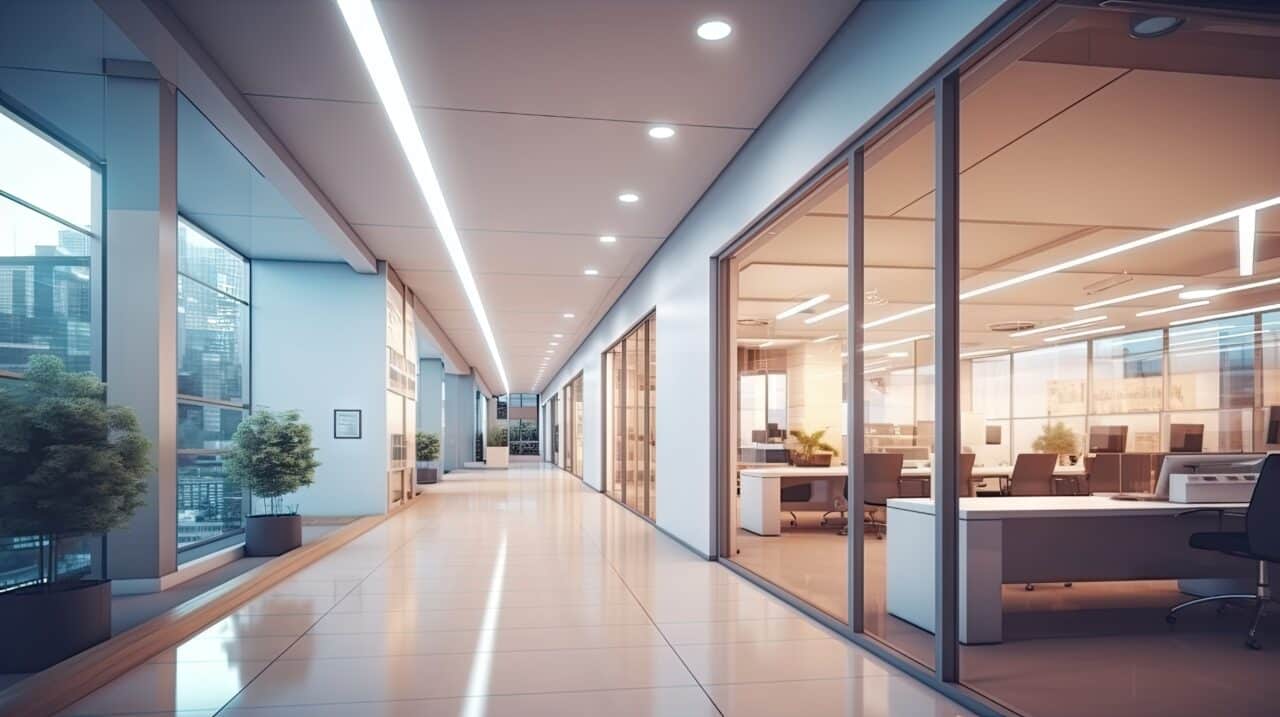Business owners and facility managers often look for ways to cut costs, increase employee productivity, and improve the customer experience. Have you considered how the right lighting solutions can significantly impact all of these areas?
Switching to energy-efficient lighting solutions can provide numerous benefits for commercial facilities. And there are a variety of options available, each with its own unique advantages.
Lee Company electricians regularly work with businesses in the Southeast to design and install lighting solutions that meet their specific needs. In this guide, we’ll explore the benefits of energy-efficient lighting and discuss some popular options for commercial properties.
Energy-Efficient Lighting Overview
The right lighting isn’t just about aesthetics — it influences everything from your energy bills to your employees’ health and your environmental footprint. Are you utilizing the best lighting technology for your commercial facility?
Here are the main types of energy-efficient lighting to consider:
LED Lighting
LEDs, or light-emitting diodes, are today’s most energy-efficient lighting option. LEDs actually use up to 75% less energy than traditional incandescent bulbs and can last between 25,000 and 50,000 hours—vastly exceeding the 750-hour lifespan of incandescent options.
This drastically reduces energy costs while enhancing overall light quality. As an example, switching a 60W incandescent bulb with a 12W LED can save over 80% in electricity costs over 1,000 hours of use.
Whether you operate a small retail store or a large warehouse facility, LED bulbs’ various sizes and brightness levels make them a versatile choice for any commercial space. They’re also available in multiple color temperatures, providing options for different atmospheres and purposes.
Fluorescent Lighting
T5 and T8 fluorescent lighting options are commonly used in commercial facilities, particularly offices and retail spaces. They are the long, tube-shaped bulbs found in suspended ceiling fixtures.
These tend to be more energy-efficient than traditional incandescent bulbs but less so than LED options.
One of the main reasons fluorescent lighting became so popular in commercial settings is its lower cost. It also tends to have better light output. However, it often flickers and produces a buzzing sound, which can be distracting for employees and customers.
Each of these technologies promises energy efficiency — but which is the best for your commercial facility?
Choosing the Right Energy-Efficient Lighting for Your Business
Consider your current lighting setup. Is it meeting your lighting and efficiency goals?
The best lighting solution for your commercial facility depends on a few factors, including:
- Space and layout: The size and shape of your space will determine the number and location of light fixtures needed.
- Color temperature: Different spaces require different types of light. Warm white (2700K) is ideal for creating a cozy atmosphere in restaurants and hotels, while cool white (4100K) may be preferred in offices, hospitals, and warehouses.
- Budget: While energy-efficient lighting can save you money over time, the initial cost of installation may vary depending on the technology
- Maintenance: Some lighting options require more frequent replacement and maintenance, which can add up over time. Consider the lifespan and replacement costs when choosing the right option for your facility.
- Lighting controls: Do you want the ability to adjust lighting levels and colors? This may be essential for businesses that require different settings throughout the day, for example, to create ambiance or conserve energy during off-hours. And we’ll go into this more in the next section.
Ultimately, your business’s best energy-efficient lighting solution will depend on your unique building and needs. Consulting with a professional electrician can help you determine the right technology and design to meet your goals and budget.
Lighting Controls and Automation
As businesses increasingly prioritize sustainability and cost-efficiency, lighting controls and automation present a multi-faceted solution. But what exactly are these systems?
Lighting controls are intelligent network-based systems that adjust lighting based on environmental and occupancy changes. Automation involves setting up these systems to operate automatically and optimizing lighting without manual intervention.
Smart lighting systems adapt to real-time occupancy and natural light levels and can significantly reduce energy waste. They can also be monitored and managed remotely, providing additional savings in time and manpower.
The different features of these systems make a real difference in your bottom line, based on research by the Lawrence Berkeley National Laboratory:
- Occupancy-based controls that automatically adjust lighting based on room usage can cut lighting energy use by about 24%.
- Daylight harvesting, which leverages natural light, can minimize the use of artificial lighting during daytime business hours by up to 28%.
- Customizing lighting levels per area or user preference can reduce energy use by 31-36%.
While this research is a bit older, we can only imagine how much more efficient and advanced lighting controls have become since then!
Implementing these strategies optimizes energy usage and ensures lighting is as efficient and non-intrusive as possible.
Could your current lighting setup benefit from an upgrade to smart controls? What would your annual savings look like with these technologies in place? Let’s explore below…
Financial Incentives and Return on Investment
Lighting accounts for a significant portion of a commercial building’s electricity bill, up to 20% annually. Transitioning to energy-efficient solutions like LED lighting significantly lowers this cost.
What can you expect in terms of real savings and financial incentives? The biggest economic impacts come from:
- Dramatic Reductions in Energy Costs: LED lighting can slash your lighting energy expenses to as little as 4%-6% of the total energy bill due to its lower power consumption and reduced heat output, which can also decrease cooling costs.
- Lower Maintenance Costs: With lifespans extending up to 50,000 hours, LED lights drastically reduce the frequency and costs associated with replacements compared to traditional lighting options.
- Tax Incentives and Rebates: Many utility companies and government programs offer incentives for energy-efficient upgrades. For example, the EPAct 179D tax deduction allows up to $5 per square foot for qualified retrofits that achieve significant energy reductions.
Based on this deduction, a 20,000-square-foot building could benefit from a $100,000 tax credit. These types of incentives lower the initial investment cost and accelerate the payback period.
When assessing the financial viability of upgrading your lighting systems, consider the speed at which energy and maintenance savings could offset your upfront expenses. And beyond the direct financial gains, consider the improved comfort and productivity that well-planned lighting can bring to your facilities.
Regulatory Compliance and Standards
Energy-efficient lighting isn’t just about your bottom line or how well it serves your business needs — it’s also about compliance.
How does your current lighting setup align with the latest energy codes and standards?
For businesses that want to reap the benefits of energy efficiency and adhere to legal requirements, understanding these regulations is a must.
Governments have set regulatory standards to encourage businesses to adopt energy-saving practices:
- International Energy Conservation Code (IECC): This code addresses energy efficiency on a broad scale, including residential and commercial buildings.
- ANSI/ASHRAE/IES Standard 90.1: This standard often serves as a benchmark for state and local codes, focusing specifically on commercial buildings.
- Title 24, Part 6 (California): Ensures energy savings and emissions reductions in building design.
These regulations generally set the standard for every state and are updated regularly, reflecting advancements in technology and changes in environmental policy.
For example, the Department of Energy now mandates that all light bulbs sold must produce at least 45 lumens per watt, effectively phasing out traditional incandescent bulbs.
This shift encourages the adoption of LEDs and aligns with broader environmental goals, such as those set by 25 U.S. governors aiming to eliminate emissions from buildings.
As you consider upgrading your lighting systems, think about the potential penalties for non-compliance and the incentives available for meeting or exceeding standards.
Are you taking full advantage of state-specific rebates and incentives that can offset the initial costs of transitioning to energy-efficient solutions?
Best Practices for Implementation of Energy-Efficient Lighting Solutions
Seeing the savings of energy-efficient lighting in your commercial facility involves more than selecting the right bulbs — it’s about strategic capital planning.
Here’s how to make sure your lighting upgrade maximizes benefits while minimizing disruptions:
Steps to Effective Implementation
- Conduct a Lighting Audit: Begin by evaluating your current energy usage and lighting efficiency. This will help identify areas for improvement and potential energy savings.
- Calculate Your Return on Investment: Once you understand your current energy usage and potential savings, calculate the return on investment (ROI) for upgrading to energy-efficient lighting. This will help determine the viability and timeline for implementing these solutions.
- Select Suitable Lighting Solutions: Consider the specific needs of different spaces within your facility. Factors such as compatibility with existing fixtures, the lighting’s impact on work areas, and the total cost of ownership are crucial.
- Plan for Regular Maintenance: Ensure your new lighting systems are maintained regularly to sustain efficiency and performance over time.
- Engage Stakeholders: Keep everyone from management to maintenance informed and involved. Their buy-in will make for a smoother transition and ongoing compliance.
Transitioning to smarter lighting solutions, such as automated controls, isn’t merely about installing them but also about thoughtfully integrating these systems into your existing infrastructure.
This might involve initial investments in equipment installation, infrastructure upgrades, system programming, functional testing, and end-user training. But the right approach to upgrading your lighting can lead to substantial cost savings, a more productive environment for workers, and a more welcoming atmosphere for customers.
Cut Costs with Energy-Efficient Lighting Upgrades from Lee Company
At Lee Company, we understand the pivotal role lighting plays in your commercial facility — not just for today but also for your business’s sustainable future and the long-term value of your property.
Here’s how we make transitioning to modern lighting solutions seamless and cost-effective:
- Tailored Lighting Audits: We start with a detailed assessment of your current lighting setup to identify areas for improvement. Our electrical experts will ask questions and carefully evaluate your building to ensure that every solution we propose maximizes energy savings and meets your specific needs.
- Customized Implementation: Whether it’s LED retrofitting or new installations of energy-efficient systems, we offer customized solutions that respect your budget constraints and operational requirements.
- Comprehensive Service Package: From the initial design to the final implementation, including regular maintenance and compliance checks, Lee Company handles every aspect to make the upgrade process as smooth as possible.
- Financial Guidance: We help you navigate the various financial incentives available, from tax rebates to energy credits, ensuring you get the maximum return on your investment.
Upgrading to energy-efficient lighting with Lee Company reduces your energy bills and maintenance costs while enhancing the overall productivity and safety of your environment! Contact us today to start seeing these benefits of energy efficiency in your business.
Upgrade to energy-efficient lighting and start saving!
CALL US NOW AT 615.567.1000

